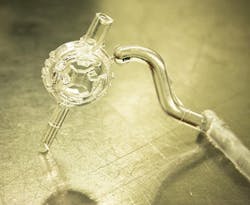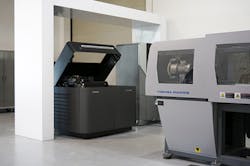3-D printer lets designer be toolmaker and molder
3-D printing is shaking up some long-established business models and helping to create some new ones.
For example, how many award-winning industrial design firms have you heard of that do plastic injection molding (IM) in house, and even make their own molds? There's at least one. Worrell Design Inc., Minneapolis, has been providing product design, development and strategy since 1976, notably to medical sector companies, but its client list also includes many well-known consumer and industrial firms.
Worrell's move into mold making and injection molding is relatively recent and is tied directly to 3-D printing. The 40-person firm sees the technology as a competitive advantage and a customer satisfaction tool. The advantage comes from reducing development cost and radically shortening the client's time to market, two things pretty much guaranteed to make a client happy.
The key to what Worrell has trademarked "3D IM" is the firm's Stratasys Object Connex500 PolyJet machine, a professional-level 3-D printer that makes accurate prototypes directly from CAD files. Worrell normally makes prototypes in the course of product development, but it now goes beyond that to make injection molds in Stratasys Digital ABS photopolymer material.
The 3D IM process starts with a 3-D product design file. Then CAD software is used to engineer the mold design. That design is 3-D printed by Worrell's Stratasys Connex500 machine. The printed mold is fine-tuned, mounted in an injection press and final parts are created in the specific material that will be used for later mass production. The production-level parts can then be used for suitability testing and regulatory approval.
Back to what makes a client happy: 3D IM takes only a few days to produce a short run — usually 100 or fewer — of production-level parts, compared with six to eight weeks for traditional tooling and molding. Worrell says 3D IM costs about 70 percent less than traditional tooling and molding, which can save the client tens of thousands of dollars.
3D IM is huge for medical device makers
Derek Mathers, Worrell's business development manager, says that every one of its clients can appreciate the time and cost savings offered by 3D IM, but for medical device makers the shortened time, along with the ease and low cost of making changes, are particularly beneficial. This has to do with the Food and Drug Administration's usability testing of any medical device.
The FDA wants to test something as close to the finished product as possible, ideally production-level parts exactly like what will be sold and used. Mathers says that if you prepare those parts using traditional tooling and short-run molding, send them to the FDA, and fail the test, you fall into what he calls the medical device Catch-22. You spent all the money and time to get this far and now you have to do it all over. Arguably worse, you have to ask management for the time and money again.
Working with 3D IM you don't have to go back to a metal mold to make the changes, nor do you have the attendant time and cost. Worrell can make the changes in the design file, and make a short run of parts in two or three days, and at much lower cost. All the arrangements for the next test can be made quickly and the entire process regains its forward momentum.
On Oct. 30 Stratasys Ltd. announced it would collaborate with Worrell to accelerate medical device development through the use of 3-D printed injection molding, Worrell's 3D IM. To promote the huge savings in both costs and product development cycles, the two companies will jointly attend trade shows and host a series of workshops to educate the medical industry on this process.
Kai Worrell, CEO at Worrell, says, "This revolutionary manufacturing process enabled by Stratasys PolyJet technology is now an integral part of our product development cycle, allowing us to provide better prototypes for care providers, while saving our clients considerable time and money."
Nadav Sella, senior manager of manufacturing tools at Stratasys, said, "We have recognized a significant underutilization of the 3-D printed IM process in medical device development and we're working with Worrell to help fill this gap. In an industry where products have the potential to save lives, we want to use this collaboration to demonstrate how medical device manufacturers can bring their products to market significantly faster than ever before."
Stratasys is also promoting the use of 3-D printed molds for injection molded, production-level prototypes in manufacturing sectors other than medical. For example, at Robert Seuffer GmbH & Co. KG, a manufacturer of electronic components, sensors and human-machine interfaces near Stuttgart, Germany, functional testing of complex assemblies is critical. The company had been using metal molds to create injection molded prototypes in the final production material, which took about eight weeks and cost around $50,000. Any changes meant more time and more money.
Seuffer decided to test a PolyJet 3-D printer as a mold making machine. It chose a geometrically complex part that included shut-off surfaces, thin walls and tall core pins that normally would require multiple inserts and many hours to fit into a metal mold base. Using the 3-D printer, a prototype mold was built in less than two days and needed only three hours of component fitting and assembly.
Not surprisingly, the benefits to Seuffer were similar to Worrell's. The PolyJet mold took two days to make and cost $1,318, versus 56 days and $52,725 for a metal mold. That's a 98 percent cost savings and 96 percent less time. Seuffer now owns the PolyJet printer. The company's R&D manager, Wilfried Zachmann, says, "The ability to functionally test parts made of the final material makes it possible to efficiently and inexpensively modify the design prior to mass production."
Rob Neilley, senior correspondent
Contact:
Worrell Design Inc.,
612-638-6000, www.worrell.com
Stratasys Ltd.,
952-937-3000, www.stratasys.com
Related story: GE ups commitment to AM


